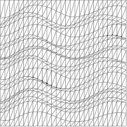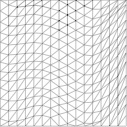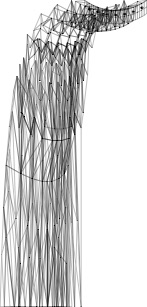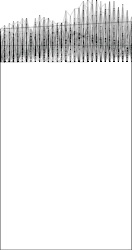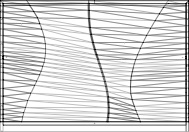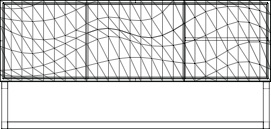The composition of all things has been explored by numerous philosophers and scientists throughout human history. For example, according to Aristotle’s The Four Causes, Formal Cause is hidden inside the object. With sustainable development, Formal Cause will emerge gradually, until it reaches the final stage. Those previous long lasting doubts are becoming more clear and straightforward in the computer environment. With computing knowledge, which contains logic, this amazing calculation ability indicates the possibilities of the formation of all things. This digital context becomes a mirror that parallels the natural world; the three dimensional dot-line-surface not only simulates the composition of the world, but also fluctuates in a certain logical environment, just like the unexpected within nature.

For human beings, the computing environment is still full of the unknown. There is no limitation of how we use digital languages to compose objects. More significantly is how we understand to use this intelligent creator fully, and how to use its power to create objects in the real world, which without doubt requires more exploration.
Over a long period of time, Zhang Zhoujie has shown a strong commitment to research into digital creation, and has always maintained focus in two directions: One is based on the digital language itself, exploring how computers are used to create objects and the processes involved in this. From looking into the digital language itself, to the process of these graphic languages, such as deep mining, we can begin to realize the existence and form of arbitrary three dimensional objects, which is the exploration within a virtual dimension. The other direction is exploration in the real world. Zhang Zhoujie integrates digital exploration with actual fabrication into a functional application, using traditional two dimensional fabrication techniques, such as hand-made joints. By repeatedly practicing, iterating and making functional pieces, as well as creating art installations, he is able to explore how to develop the ultimate fabrication technique of digital design. How will the computer change the formation of real objects? Zhang Zhoujie embraces these doubts, and is undoubtedly a pioneer in this field.

Zhang Zhoujie has began a long journey of exploration into this field of digital design. In the contemporary world, the increasing popularity of 3D printing, the Internet of Things (IoT) and Smart Living has caused a new Digital Revolution. However, a return to traditional production methods has exploited a huge gap within this area of digital design. In the narrow sense of art and design, to combine digital generation and relatively inexpensive production methods, there is a new space to let creativity abound in endless ways due to the calculation abilities of computers, which is also leading to tailor-made creations by independent designers.
The origin of his research is about the transformation process of digital language, this was always the vision of Zhang Zhoujie’s work. The complicated nature and complexity which this process presented, is the result of this research. Nevertheless, the fabricated installations and objects are the concrete reality of these results. With this solo exhibition, Zhang Zhoujie Digital Lab focuses on Mesh, the fundamental graphic language, its transformation process and attempts to present the possibilities, from virtual to reality, of digital design in the form of installations and functional objects.
“Mesh, as a primary computer algorithm, is like a language, a material, which is full of potential in my eyes. How to use mesh to break through the way that the world thinks, requires a vast amount of research and experimentation”, says Zhang Zhoujie. Though it looks like a very common graphic language, Mesh is a material, just like material in our daily life. How to use this material to generate objects in a digital language, we need to explore more and to follow the various clues we find along the way.

During 2016 the Mesh State series was defined. From simulating water ripples in limited squares, to a computer generated river installation, the project went from preliminary research of forming mesh, and finally to fabrication. In 2017, the research will go wider and deeper, with usage of the mesh language more complicated and radical, such as variations of elevations, and extreme dynamic conditions. This will also increase the actual fabrication difficulties, which not only creates more complicated levels, but also more complex stereochemical structures. More research will be carried out to explore higher levels of actual fabrication, which can be seen in the exhibited square columns in this exhibition.
In 2016, with the ‘Inspired By Land’ Land Art Installation Festival, Zhang Zhoujie Digital Lab combined real terrain data, and digitally generated a switchback stream installation, which adds continuity to this exhibition. Starting from a relatively flat stream, and then turning into a rough waterfall, the strong height contrary reflects the Mesh digital language, simulating dramatic real world experiences such as the stock index. The difficulty of realizing this installation, and the different angles and visual perception in the space, also highlights another side of digital design.
The 2016 Mesh collection could be regarded as the focus of this exhibition. If that collection presents the possibilities of simulating water ripples in the form of an installation, then the newly created cabinets deepen the idea of digital design, and establishes a foothold for it within practical daily usage. This series of cabinets have different dimensions, and along with each profile, the superficial Mesh form has different characteristics. All these details have a symbiotic harmony with digital design.

This exhibition will be held in a limited space, and as such leads to another significant area of digital design as applied in real world circumstances: Based in a limited space, using a computer one is able to generate tailor-made proposals according to real data. For example, the pendant lamp, which combines the exhibition space’s three-dimensional data, simulates a curve that goes through the space. Hand made and welded, the dynamic LED pendant lamp is created, the inner lights shining through, giving a tridimensional experience.
To Zhang Zhoujie, the boundary between art and design is not definitive. One of the results to come out of this research examines whether using digital languages helps to incubate new forms of art, and the relationship between installation and functional objects. Looking to the future, Zhang Zhoujie would like to try using different materials in the fabrication process. As a pioneer in this area of practical digital creation, his research helps to enlighten creators in other realms. What is gradually revealed is a new digital future hidden within his exhibits.
When man first observed the world, philosophers such as Aristotle agreed that the formation of all things was the result of a natural changing process that have internal motivations. When considering artificial languages, due to the computer’s random evolution within nature, digital design has gradually come closer to a purer method of formation. Perhaps in the future it will be the same at some point.


